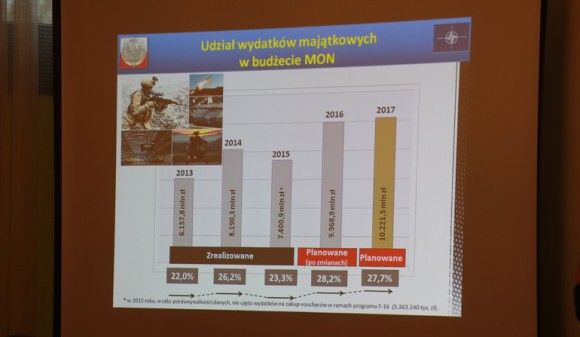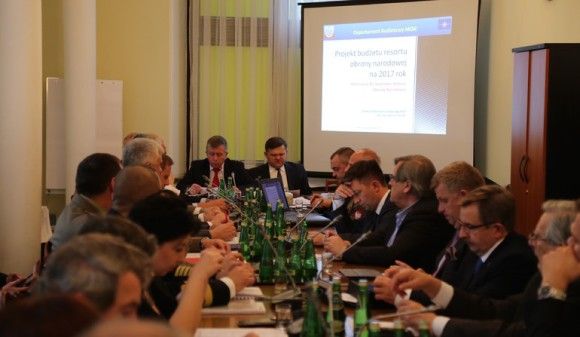RADMOR Ready To Design The “European” Programmable Radio
Three HDR waveform interoperability demonstrations organized by RADMOR S.A. for the NATO member states in Gdynia, between November and December this year, have proven that the software kit developed within the scope of the European ESSOR programme has reached high level of effectiveness. The said software makes it possible, for a variety of programmable radios manufactured by a variety of companies, to cooperate. Hence, the suite may be used to manufacture the latest generation of the Polish radio communication systems. According to RADMOR, the initiative is delayed, as the procedural arrangements and approval of the Tactical-Technical requirements are prolonged.
ESSOR (European Secured SOftware defined Radio) is one of the European research and development initiatives pursued within the area of defence, the purpose of which is, above all, to develop architecture for software-defined radios, also referred to as “coalition radios”, and secondly, the goal assumed by the Polish company is to create a software suite that would allow for broadband broadcasting of voice and data – so called waveform ESSOR HDR.
We may create future-radios, but the army needs to be interested.
Thanks to the works realized within the initial phase of the programme, finalized in June 2015, the engineers, including the IT specialists, have managed to provide full interoperability between the SDR radios, manufactured by a variety of companies.
As it is stressed in the official release: “for the first time in history, globally, we have managed, through cooperation of several companies, to develop an extremely efficient broadband waveform, and to prove its interoperability, through using several heterogeneous platforms, manufactured by companies from several different countries”.
ESSOR actively involves six, well known companies, including: Finnish Elektrobit company, French Thales, Spanish Indra, Saab, SELEX Communications from Italy and finally - the Polish RADMOR company, based in Gdynia. Thanks to this fact, Poland has gained full access to the results and technologies obtained through the programme, and it may use this information for further development of the Polish new generation radios.
The above task will be easier, as the RADMOR company, throughout the years, has gathered rich expertise in the field of radio communications, as the systems manufactured by RADMOR are being used by 16 armies, worldwide. The experts note that when experience in implementation of the ESSOR HDR waveform and SDR platforms is added to the equation, the Gdynia-based company may design and manufacture modern, original military radios, providing the user with top level of protection, regarding the information that is being transmitted with the use of the aforementioned systems.
According to RADMOR, a delay in the programme emerged right from its beginning, in the light of the prolonged arrangements regarding the initial tactical and technical assumptions, pertaining the communications suite of this type. Other members of the ESSOR programme have already presented prototypes or even the working models of the developed new generation radios, compliant with the ESSOR standards.
Meanwhile, a lot of work has already been completed in Poland, e.g. thanks to the funds provided by the National Centre for Research and Development. The National Centre for Research and Development has initiated the GUARANA “Portable Radio” project, the aim of which is to develop the first Polish programmable ESSOR-compliant radiocommunications suite. The works related to this project are being realized by an exclusively Polish consortium, led by the RADMOR company.
What has been really developed, within the scope of the ESSOR initiative?
The demonstrations taking place in Gdynia, organized by the RADMOR company, were to make the government and the industry aware of the importance of solutions that have been already developed within the scope of the ESSOR programme. The demonstrations involved, in a role of observers, the representatives of the NATO Communications and Information Agency, members of the NATO Headquarters Consultation, Command and Control and representatives of the OCCAR organization (Organisation conjointe de coopération en matière d’armement), as well as the representatives of the states working together within the coalition for wideband networking waveform, namely, Australia, Canada, Germany, the US, and the United Kingdom. Moreover, the presentations were attended by representatives of the Netherlands, Norway, Turkey, and by representatives of the companies involved in the ESSOR programme, coming from Finland, France, Spain, Poland, Sweden and Italy.
The demonstrations were realized by showcasing a variety of scenarios, in which a network of six, cooperating, communication nodes was being utilized. The nodes were being organized with the use of a variety of SDR radios, provided by four companies: Thales, Selex ES, Bittium and, finally, by RADMOR.
Thanks to the fact that the presentation was conducted in the above described manner, it was possible to confirm the interoperability capabilities, referring to the SDR programmable radios manufactured by a variety of companies. Moreover, it was also possible to demonstrate the “usability of the methodology of the ESSOR programme, within the scope of providing waveform’s portability, and high class of ESSOR HDR waveform, proven by the parameters achieved, when the device was operated as a network broadband medium”.
According to the official release, besides the interoperability demonstration pertaining the developed waveform, the most important functions of the newly developed system were also showcased, including:
- MANET (self-organizing network);
- Synchronization – all “with” or “without” nodes, GNSS/mixed network;
- Dynamic assignment of resources and adaptation to the network traffic requirements;
- Full security of the data transmission (TRANSEC, NETSEC, COMSEC) with separation between secret and public sections (“red” and “black”);
- Support for national data transmission in coalition networks, thanks to “end-to-end” encoding;
- Embedded OTAR/D/Z mechanism, making it possible to remotely switch off (eliminate) a node;
- Unicast transmission, in which a single sender and a single receiver exists; Multicast transmission, with numerous recipients; and Broadcast (wide distribution) transmission with QoS;
- Real-time video transmission;
- VoIP conferences, according to “point-point” and “point-multipoint” schemes, including encrypted voice transmission, with the use of the SCIP protocol (compliant with STANAG 5068 norm – this implementation has been developed and created by RADMOR S.A.).
ESSOR is a research and development programme, that has been initiated on 18th December 2008 (the contract has been signed on 1st December 2009) by Finland, France, Italy, Poland and Spain. On behalf of the involved states, the programme is being managed by the OCCAR organization, cooperating with the European Defence Agency, with the latter organ monitoring the programme, and providing the participants with relevant information regarding the similar initiatives realized within the EDA framework.






